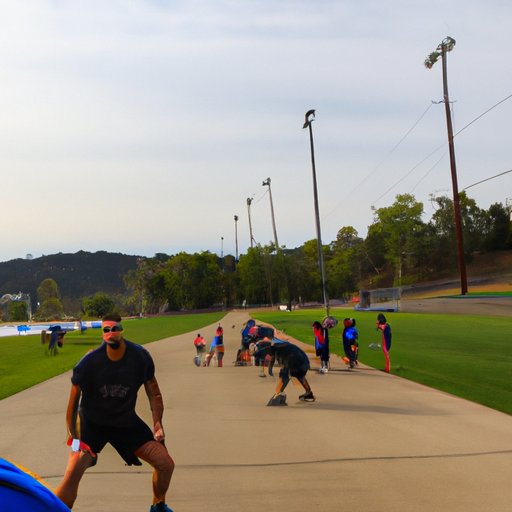
I. Introduction
Push-ups are one of the most basic yet effective exercises for building upper body strength and endurance. Whether you’re a beginner or an experienced gym-goer, learning how to do a push-up with proper form and technique can help you achieve your fitness goals and prevent injury.
The purpose of this article is to provide a step-by-step guide to performing a push-up correctly, highlighting common mistakes and variations, and outlining the benefits of regularly incorporating push-ups into your workout routine.
II. Step-by-Step Guide
Before starting any exercise, it’s essential to ensure you have the proper form and technique. Here are the steps to performing a standard push-up:
- Get into the plank position with your hands slightly wider than shoulder-width apart and your feet hip-width apart.
- Keep your arms straight and engage your core, glutes, and legs to create a straight line from your head to heels.
- Bend your elbows, lowering yourself towards the floor, while keeping your body straight. Exhale as you push back up to start position.
- Repeat the movement, aiming for a full range of motion as long as you can maintain proper form.
It’s essential to breathe properly when doing push-ups. Inhale as you lower yourself towards the floor and exhale as you push up from the floor. This breathing pattern will help to engage your core and muscles more effectively.
To ensure proper form throughout the exercise, here are some tips:
- Keep your elbows tucked in and close to your body.
- Engage your core and glutes to keep a straight line from your head to heels.
- Avoid sagging hips or bending at the waist, as it could cause lower back strain.
- Lower your chest towards the ground and keep your head up, looking ahead of you.
III. Common Mistakes
Even with proper instruction, it’s easy to make mistakes when performing push-ups. Here are some common mistakes to avoid:
- Sagging hips: the lower back drops towards the floor and the hips dip down towards the ground.
- Flaring elbows: the elbows extend outwards away from the body.
- Bending at the waist: the lower back curves, and the hips move up towards the ceiling.
- Not lowering your chest enough: the chest barely goes towards the floor, limiting the range of motion and effectiveness of the exercise.
To correct these common mistakes, here are some tips:
- Engage your core and glutes to keep a straight line from your head to heels.
- Tuck your elbows in and keep them close to your body.
- Lower your chest towards the floor and keep your gaze forward to maintain proper form.
- Focus on using your chest, shoulders, and triceps to lower your body towards the ground.
IV. Variations
Push-ups can be modified to suit your fitness level and target different muscle groups. Here are some variations to try:
- Modified push-up: performed on your knees instead of your toes, this variation is an excellent starting point for beginners.
- Wide push-up: the arms are placed wider than the shoulders, targeting the chest muscles.
- Diamond push-up: hands are positioned together to form a diamond shape, targeting the triceps.
- Incline push-up: hands are placed on a raised surface such as a bench or box to reduce the weight-bearing load and intensity, mainly targeting the chest muscles.
- Decline push-up: feet are placed on an elevated surface such as a step or box, increasing the weight-bearing load and targeting the triceps.
- Explosive push-up: push yourself off the floor with force and lift your hands and feet off the ground, targeting the chest, shoulders, and core muscles.
When performing variations, remember to maintain proper form and breathe correctly to engage the correct muscles effectively.
V. Benefits
Push-ups offer a range of benefits for the body, including:
- Building upper body strength and endurance in the chest, shoulders, triceps, and core muscles
- Improving posture by developing back, shoulder, and core strength
- Burning calories and reducing body fat, making it a great exercise for weight loss
- Increasing bone density, improving bone health
- Reducing the risk of injury by strengthening joints, muscles, and bones
According to a study by the American Council on Exercise, push-ups are an effective exercise that targets multiple muscle groups simultaneously and helps reduce the risk of injury during daily activities.
VI. Routine
Regularly incorporating push-ups into your workout routine can help you achieve your fitness goals more effectively. Here are some recommendations:
- Start with 3 sets of 10-15 reps of standard push-ups or a modified variation that suits your fitness level.
- Gradually increase the number of push-ups per set as you progress, aiming for at least 20-25 reps per set.
- Perform push-ups at least three times a week, allowing for rest days in between to help prevent injury and muscle fatigue.
- Track your progress and increase the intensity by incorporating more challenging variations or increasing the weight-bearing load, such as wearing a weighted vest.
VII. Conclusion
Push-ups are a simple yet effective exercise that can help you build upper body strength, improve posture, burn calories, and reduce the risk of injury. By following the steps outlined in this article, you can perform push-ups with proper form and technique and enjoy the benefits of a stronger, healthier body.





